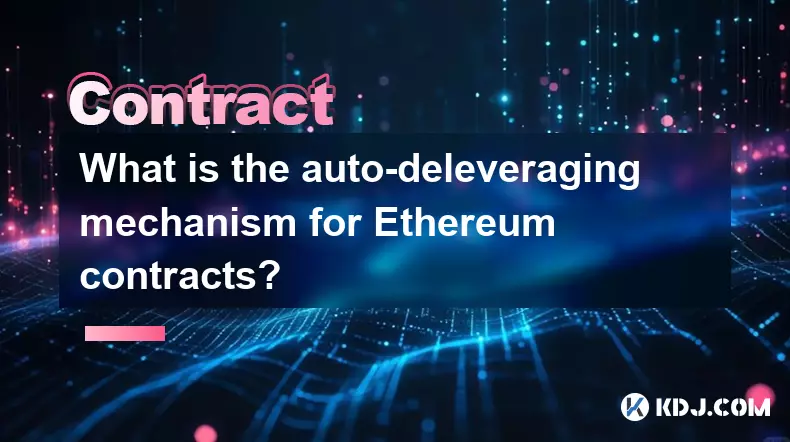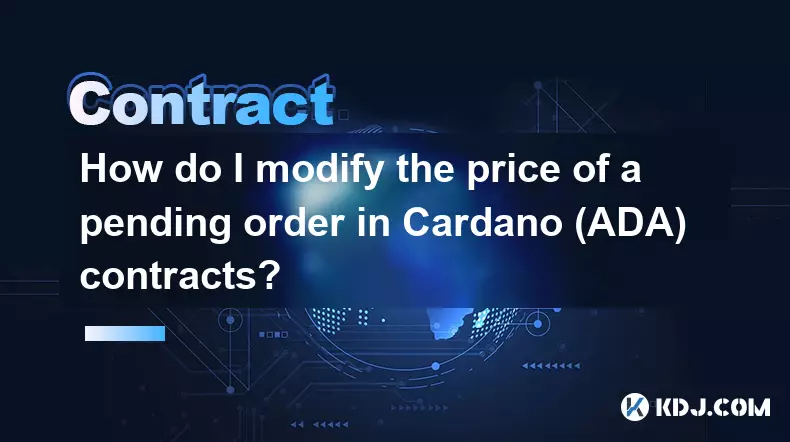-
 bitcoin
bitcoin $109523.663807 USD
-0.13% -
 ethereum
ethereum $4019.526508 USD
2.06% -
 tether
tether $1.000482 USD
0.00% -
 xrp
xrp $2.776815 USD
0.18% -
 bnb
bnb $958.942396 USD
0.12% -
 solana
solana $204.294698 USD
3.84% -
 usd-coin
usd-coin $0.999693 USD
0.00% -
 dogecoin
dogecoin $0.232115 USD
2.09% -
 tron
tron $0.338028 USD
0.84% -
 cardano
cardano $0.790920 USD
1.50% -
 hyperliquid
hyperliquid $44.871443 USD
5.60% -
 ethena-usde
ethena-usde $1.000322 USD
0.04% -
 chainlink
chainlink $21.034165 USD
2.60% -
 avalanche
avalanche $28.794831 USD
-0.54% -
 stellar
stellar $0.360466 USD
1.24%
What is the auto-deleveraging mechanism for Ethereum contracts?
Auto-deleveraging on Ethereum-based platforms ensures market solvency by forcibly closing profitable opposing positions when liquidations exceed insurance funds.
Sep 26, 2025 at 08:01 am

Understanding Auto-Deleveraging in Ethereum-Based Derivatives
1. Auto-deleveraging is a risk management mechanism primarily used in decentralized derivatives platforms built on Ethereum, especially within perpetual futures exchanges. When a trader’s position becomes insolvent and the insurance fund cannot fully cover the loss, the protocol initiates auto-deleveraging to settle the debt by forcibly closing offsetting positions of profitable traders. This process ensures that obligations are met without relying solely on platform reserves.
2. The mechanism activates when a liquidation event occurs and the system lacks sufficient funds to absorb the loss from a bankrupt position. Instead of spreading the burden across all users or depleting the insurance fund entirely, the protocol selects counterparties who are on the opposite side of the market and have high profitability. These traders experience partial closure of their positions to balance the deficit.
3. Execution follows a rank-based order, typically starting with the most leveraged and profitable opposing positions. The amount deducted depends on the size of the shortfall and the leverage used by the counterparty. This targeted approach minimizes systemic impact while preserving market integrity.
4. Smart contracts on Ethereum automate this entire workflow. On-chain logic evaluates account health, triggers liquidations, and executes auto-deleveraging based on predefined rules encoded during deployment. Transparency is ensured as all operations are publicly verifiable through transaction logs and contract state changes.
5. Because Ethereum supports complex state transitions and composability, platforms can integrate price oracles, liquidity pools, and governance modules into the auto-deleveraging framework. This allows dynamic adjustments based on volatility, funding rates, and open interest levels, making the system resilient under extreme market stress.
How Profitable Traders Are Selected for ADL
1. Selection relies on an algorithmic ranking system embedded in the smart contract. The primary factors include the trader’s current profit level, leverage ratio, and position size relative to the opposing side of the insolvent trade.
2. Traders with higher unrealized profits and greater leverage are prioritized. For instance, a long position with 20x leverage showing substantial gains will be more likely to be targeted than a conservatively leveraged one.
3. The protocol maintains an ADL queue that updates in real time based on market movements and position changes. Users can often view their standing in the queue via the platform interface, enabling better risk planning.
4. Once selected, only the necessary portion of the position is closed to cover the shortfall. Full liquidation does not occur unless the required amount matches the entire position value.
5. This tiered selection prevents monopolization of losses by a single user and distributes the adjustment across multiple accounts proportionally, maintaining fairness within the ecosystem.
Impact on Market Stability and User Behavior
1. Auto-deleveraging contributes to solvency by preventing cascading failures during flash crashes or rapid volatility spikes. Without such a mechanism, insolvency events could trigger broader trust erosion in decentralized exchanges.
2. It discourages excessive leverage since highly leveraged traders face higher chances of being drawn into ADL events. This self-regulating feature promotes responsible trading practices across the network.
3. Transparent execution on Ethereum means every step—from detection of insolvency to final settlement—is recorded immutably. Auditors and users can verify each action, enhancing confidence in platform reliability.
4. Some platforms implement rebates or compensation mechanisms for users affected by ADL, funded through trading fees or token incentives. These measures aim to reduce friction and retain active participants.
5. Frequent activation of auto-deleveraging may signal underlying issues such as inadequate collateral models or poor oracle responsiveness. Development teams monitor these occurrences closely to refine risk parameters.
Frequently Asked Questions
What triggers auto-deleveraging in a decentralized exchange?Auto-deleveraging is triggered when a trader's position is liquidated and the available insurance fund cannot cover the resulting loss. The system then automatically closes opposing profitable positions to settle the outstanding obligation.
Can users avoid being part of the auto-deleveraging process?Yes. Traders can reduce their exposure by using lower leverage, managing position sizes carefully, and monitoring their rank in the ADL queue. Closing positions before extreme market moves also helps avoid involuntary closures.
Is auto-deleveraging unique to Ethereum-based platforms?While the concept exists across various derivative markets, its implementation via smart contracts is particularly prominent on Ethereum due to its robust programmability and widespread adoption in DeFi applications.
How transparent is the auto-deleveraging process?The process is fully transparent on Ethereum. All triggering conditions, calculations, and executions are handled by open-source smart contracts, allowing anyone to audit transactions and verify fairness.
Disclaimer:info@kdj.com
The information provided is not trading advice. kdj.com does not assume any responsibility for any investments made based on the information provided in this article. Cryptocurrencies are highly volatile and it is highly recommended that you invest with caution after thorough research!
If you believe that the content used on this website infringes your copyright, please contact us immediately (info@kdj.com) and we will delete it promptly.
- Whales, Trump Coin, and Crypto: A New York Minute on What's Hot (and What's Not)
- 2025-09-27 10:25:17
- SWIFT Tests On-Chain Messaging with Linea: A New Era for Global Finance?
- 2025-09-27 10:25:17
- Binance Coin, WLFI, Crypto Presales: Decoding 2025's Hottest Trends
- 2025-09-27 10:45:15
- MoonBull, Crypto, and Snek Cheems: Navigating the Meme Coin Mania in 2025
- 2025-09-27 10:30:02
- Dogecoin's Rocky Road: Resistance and Price Decline - What's Next?
- 2025-09-27 10:45:15
- Meme Coins: Will Dogecoin and Shiba Inu Ever See Another Boom?
- 2025-09-27 10:50:01
Related knowledge

How do I enable the "scalping-only" mode for Cardano (ADA) contracts?
Sep 24,2025 at 03:19am
Understanding Scalping Strategies in Crypto Derivatives1. Scalping in cryptocurrency trading refers to executing multiple short-term trades within min...

What is the maximum position limit for Cardano (ADA) contracts?
Sep 23,2025 at 11:00pm
Understanding ADA Futures and Derivatives Market Structure1. Cardano (ADA) futures contracts are offered by several major cryptocurrency derivatives e...

What is the maker fee for Cardano (ADA) contracts?
Sep 26,2025 at 09:01am
Understanding Maker Fees in Cardano (ADA) Contracts1. The concept of maker fees applies broadly across decentralized exchanges and smart contract plat...

How can I view open interest in Cardano (ADA) contracts?
Sep 24,2025 at 07:36am
Understanding Open Interest in Cardano Derivatives1. Open interest refers to the total number of outstanding derivative contracts, such as futures or ...

How do I modify the price of a pending order in Cardano (ADA) contracts?
Sep 27,2025 at 01:00am
Understanding Pending Orders in Cardano Smart Contracts1. Cardano operates on a proof-of-stake blockchain that supports smart contracts through its Pl...

What is the function of the insurance fund in Cardano (ADA) contracts?
Sep 24,2025 at 02:18am
Understanding the Role of Insurance Funds in Cardano Smart Contracts1. The insurance fund within Cardano's ecosystem is not a native feature directly ...

How do I enable the "scalping-only" mode for Cardano (ADA) contracts?
Sep 24,2025 at 03:19am
Understanding Scalping Strategies in Crypto Derivatives1. Scalping in cryptocurrency trading refers to executing multiple short-term trades within min...

What is the maximum position limit for Cardano (ADA) contracts?
Sep 23,2025 at 11:00pm
Understanding ADA Futures and Derivatives Market Structure1. Cardano (ADA) futures contracts are offered by several major cryptocurrency derivatives e...

What is the maker fee for Cardano (ADA) contracts?
Sep 26,2025 at 09:01am
Understanding Maker Fees in Cardano (ADA) Contracts1. The concept of maker fees applies broadly across decentralized exchanges and smart contract plat...

How can I view open interest in Cardano (ADA) contracts?
Sep 24,2025 at 07:36am
Understanding Open Interest in Cardano Derivatives1. Open interest refers to the total number of outstanding derivative contracts, such as futures or ...

How do I modify the price of a pending order in Cardano (ADA) contracts?
Sep 27,2025 at 01:00am
Understanding Pending Orders in Cardano Smart Contracts1. Cardano operates on a proof-of-stake blockchain that supports smart contracts through its Pl...

What is the function of the insurance fund in Cardano (ADA) contracts?
Sep 24,2025 at 02:18am
Understanding the Role of Insurance Funds in Cardano Smart Contracts1. The insurance fund within Cardano's ecosystem is not a native feature directly ...
See all articles










































































